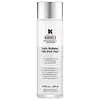What's inside
What's inside
 Key Ingredients
Key Ingredients

 Benefits
Benefits

 Concerns
Concerns

 Ingredients Side-by-side
Ingredients Side-by-side

Water
Skin ConditioningHydrogenated Polydecene
EmollientCaprylic/Capric Triglyceride
MaskingSqualane
EmollientCarthamus Tinctorius Seed Oil
Masking1,2-Hexanediol
Skin ConditioningPEG-6 Caprylic/Capric Glycerides
EmulsifyingPEG-40 Glyceryl Cocoate
EmulsifyingPhenoxyethanol
PreservativeSodium Coceth Sulfate
CleansingCapryloyl Salicylic Acid
ExfoliatingTromethamine
BufferingEthylhexylglycerin
Skin ConditioningCitrus Nobilis Peel Oil
MaskingAdenosine
Skin ConditioningLimonene
PerfumingCaprylyl Glycol
EmollientAnthemis Nobilis Flower Oil
MaskingCupressus Sempervirens Leaf/Nut/Stem Oil
EmollientPrunus Amygdalus Dulcis Seed Extract
Skin ConditioningBenzyl Alcohol
PerfumingXanthan Gum
EmulsifyingSilybum Marianum Extract
Skin ConditioningTocopherol
AntioxidantDehydroacetic Acid
PreservativeLactic Acid
BufferingWater, Hydrogenated Polydecene, Caprylic/Capric Triglyceride, Squalane, Carthamus Tinctorius Seed Oil, 1,2-Hexanediol, PEG-6 Caprylic/Capric Glycerides, PEG-40 Glyceryl Cocoate, Phenoxyethanol, Sodium Coceth Sulfate, Capryloyl Salicylic Acid, Tromethamine, Ethylhexylglycerin, Citrus Nobilis Peel Oil, Adenosine, Limonene, Caprylyl Glycol, Anthemis Nobilis Flower Oil, Cupressus Sempervirens Leaf/Nut/Stem Oil, Prunus Amygdalus Dulcis Seed Extract, Benzyl Alcohol, Xanthan Gum, Silybum Marianum Extract, Tocopherol, Dehydroacetic Acid, Lactic Acid
Water
Skin ConditioningButylene Glycol
HumectantGlycerin
HumectantDipropylene Glycol
HumectantAlcohol Denat.
AntimicrobialMethyl Gluceth-10
EmulsifyingPhenoxyethanol
PreservativePPG-6-Decyltetradeceth-30
EmulsifyingChlorphenesin
AntimicrobialParfum
MaskingCapryloyl Salicylic Acid
ExfoliatingTetrasodium EDTA
Iris Florentina Root Extract
MaskingSodium Hyaluronate
HumectantXanthan Gum
EmulsifyingCitric Acid
BufferingSodium Citrate
BufferingAdenosine
Skin ConditioningLimonene
PerfumingWater, Butylene Glycol, Glycerin, Dipropylene Glycol, Alcohol Denat., Methyl Gluceth-10, Phenoxyethanol, PPG-6-Decyltetradeceth-30, Chlorphenesin, Parfum, Capryloyl Salicylic Acid, Tetrasodium EDTA, Iris Florentina Root Extract, Sodium Hyaluronate, Xanthan Gum, Citric Acid, Sodium Citrate, Adenosine, Limonene
Alternatives
Ingredients Explained
These ingredients are found in both products.
Ingredients higher up in an ingredient list are typically present in a larger amount.
Adenosine is in every living organism. It is one of four components in nucleic acids that helps store our DNA.
Adenosine has many benefits when used. These benefits include hydrating the skin, smoothing skin, and reducing wrinkles. Once applied, adenosine increases collagen production. It also helps with improving firmness and tissue repair.
Studies have found adenosine may also help with wound healing.
In skincare products, Adenosine is usually derived from yeast.
Learn more about AdenosineCapryloyl Salicylic Acid comes from salicylic acid, the famous acne-fighting BHA.
It usually goes by a more common name of LHA, or lipohydroxy acid.
Like salicylic acid, this ingredient is a chemical exfoliant that can help break down the oil in your pores and reduce inflammation.
Though studies for LHA do show it to be less effective than salicylic acid. To be fair, salicylic acid is the reigning monarch of acne treatments.
However, a study from 2009 found LHA to be comparable to BPO, making it a good alternative for people with sensitive skin. Another study of 14 patients found a significant decrease in comedones after using LHA.
Another pro of LHA? It is less irritating than salicylic acid due to its large molecule size.
Large molecules cannot penetrate skin as well, so they are gentler on the skin. LHA is much less penetrative than salicylic acid.
An in-vitro study (not done on a living organism) found only 6% of LHA penetrated past the statum corneum compared to 58% of salicylic acid. An in-vivo (done on a living organism) analysis revealed ~17% of LHA was still present in the top layer of skin after 4 days, versus ~9% of salicylic acid.
Interestingly, a study from 2008 found LHA comparable to another famous acid, glycolic acid.
This study found about 10% of LHA is as effective as 20-50% of glycolic acid in treating hyperpigmentation and fine-lines.
Hydroxy acids have been found to stimulate skin protein, lipids, and thermal thickening. This may have anti-aging benefits.
Learn more about Capryloyl Salicylic AcidLimonene is a fragrance that adds scent and taste to a formulation.
It's found in the peel oil of citrus fruits and other plants such as lavender and eucalyptus. The scent of limonene is generally described as "sweet citrus".
Limonene acts as an antioxidant, meaning it helps neutralize free radicals.
When exposed to air, oxidized limonene may sensitize the skin. Because of this, limonene is often avoided by people with sensitive skin.
The term 'fragrance' is not regulated in many countries. In many cases, it is up to the brand to define this term. For instance, many brands choose to label themselves as "fragrance-free" because they are not using synthetic fragrances. However, their products may still contain ingredients such as essential oils that are considered a fragrance.
Learn more about LimonenePhenoxyethanol is a preservative that has germicide, antimicrobial, and aromatic properties. Studies show that phenoxyethanol can prevent microbial growth. By itself, it has a scent that is similar to that of a rose.
It's often used in formulations along with Caprylyl Glycol to preserve the shelf life of products.
Water. It's the most common cosmetic ingredient of all. You'll usually see it at the top of ingredient lists, meaning that it makes up the largest part of the product.
So why is it so popular? Water most often acts as a solvent - this means that it helps dissolve other ingredients into the formulation.
You'll also recognize water as that liquid we all need to stay alive. If you see this, drink a glass of water. Stay hydrated!
Learn more about WaterXanthan gum is used as a stabilizer and thickener within cosmetic products. It helps give products a sticky, thick feeling - preventing them from being too runny.
On the technical side of things, xanthan gum is a polysaccharide - a combination consisting of multiple sugar molecules bonded together.
Xanthan gum is a pretty common and great ingredient. It is a natural, non-toxic, non-irritating ingredient that is also commonly used in food products.
Learn more about Xanthan Gum